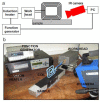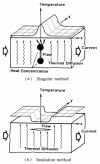Recent Advances in Active Infrared Thermography for Non-Destructive Testing of Aerospace Components
- PMID: 29462953
- PMCID: PMC5856039
- DOI: 10.3390/s18020609
Recent Advances in Active Infrared Thermography for Non-Destructive Testing of Aerospace Components
Abstract
Active infrared thermography is a fast and accurate non-destructive evaluation technique that is of particular relevance to the aerospace industry for the inspection of aircraft and helicopters' primary and secondary structures, aero-engine parts, spacecraft components and its subsystems. This review provides an exhaustive summary of most recent active thermographic methods used for aerospace applications according to their physical principle and thermal excitation sources. Besides traditional optically stimulated thermography, which uses external optical radiation such as flashes, heaters and laser systems, novel hybrid thermographic techniques are also investigated. These include ultrasonic stimulated thermography, which uses ultrasonic waves and the local damage resonance effect to enhance the reliability and sensitivity to micro-cracks, eddy current stimulated thermography, which uses cost-effective eddy current excitation to generate induction heating, and microwave thermography, which uses electromagnetic radiation at the microwave frequency bands to provide rapid detection of cracks and delamination. All these techniques are here analysed and numerous examples are provided for different damage scenarios and aerospace components in order to identify the strength and limitations of each thermographic technique. Moreover, alternative strategies to current external thermal excitation sources, here named as material-based thermography methods, are examined in this paper. These novel thermographic techniques rely on thermoresistive internal heating and offer a fast, low power, accurate and reliable assessment of damage in aerospace composites.
Keywords: aerospace structures; composite materials; infrared thermography; material damage; non-destructive evaluation; smart materials.
Conflict of interest statement
The authors declare no conflict of interest.
Figures

























References
-
- Boccardi S., Boffa N.D., Carlomagno G.M., Maio L., Meola C., Ricci F. Infrared thermography and ultrasonics to evaluate composite materials for aeronautical applications. J. Phys. 2015;658:012007. doi: 10.1088/1742-6596/658/1/012007. - DOI
-
- Montesano J., Bougherara H., Fawaz Z. Application of infrared thermography for the characterization of damage in braided carbon fiber reinforced polymer matrix composites. Compos. Part B Eng. 2014;60:137–143. doi: 10.1016/j.compositesb.2013.12.053. - DOI
-
- De Angelis G., Dati E., Bernabei M., Betti L., Menner P. Non Destructive Investigation of disbonding damage in air cooling inlet composite panel using active thermography and shearography. MAYFEB J. Mater. Sci. 2016;1:10–20.
-
- Ranjit S., Choi M., Kim W. Quantification of defects depth in glass fiber reinforced plastic plate by infrared lock-in thermography. J. Mech. Sci. Technol. 2016;30:1111–1118. doi: 10.1007/s12206-016-0215-5. - DOI
-
- Rana S., Fangueiro R., editors. Advanced Composite Materials for Aerospace Engineering: Processing, Properties and Applications. Woodhead Publishing; Cambridge, UK: 2016.
Publication types
LinkOut - more resources
Full Text Sources
Other Literature Sources

